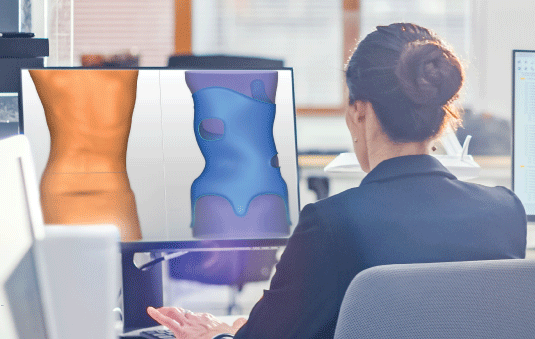Treatment Journey

True 3D Assessment
Using a portable, highly-accurate 3D scanner, in conjunction with an iPad and proprietary software app called BraceScan, each patient is scanned in 3D across 360 degrees in various postures.
This cutting edge approach is time efficient, highly accurate and radiation free. It is also convenient for patients with limited mobility and eliminates the need for casting in younger patients.



Customized Brace Design
BraceScan then combines the 3D scans with digital x-rays, posture photos, and other important clinical information to begin the brace design process.
Expert CAD designers design the brace, ensuring that the end product, ScoliBrace®, is the most effective brace for the patient.

Brace Manufacture
Through central computer aided manufacture (CAM), all braces are made by an experienced, dedicated team. Each is made following the ScoliBrace protocols and algorithm with cutting edge technology, ensuring consistency and quality.



Brace Fitting
Every ScoliBrace is professionally fitted at the patient’s brace fitting consultation. Clinicians will discuss the treatment management plan and make any necessary modifications to the brace for comfort or correction. A scoliosis specific exercise program, such as ScoliBalance, may also be prescribed.

Regular Reviews
Each patient’s progress will be reviewed regularly at scheduled visits. Progress and any other changes will be monitored closely and adjustments made to the ScoliBrace and treatment plan as needed, aiming for the best possible outcomes.



Ongoing Care & Support After Brace Treatment
Ongoing support services are provided for patients after their treatment journey has concluded.
Contra-Indications and Risks
Every medical procedure has certain contra-indications and associated risks. Given that scoliosis bracing is minimally invasive the risks are low and there are few contra-indications, however patients should be aware of the following:
Contra-Indications
- Bracing may not be suitable for patients with significant radiculopathy especially if bracing worsens symptoms.
- Bracing may not be suitable for patients who have active metastatic disease in their spine.
- Bracing may not be the ideal treatment for curves greater than 60 degrees particularly in children, however in special circumstances, bracing may be considered if other treatments such as surgical intervention are not suitable.
Risks
- As with all medical procedures there is an inherent risk that the desired outcome may not be achieved i.e. there is a small subgroup of patients whose scoliosis may continue to worsen with bracing treatment.
- The most common side effects from bracing are initial discomfort during the weaning-in period, skin irritation and very rarely breakdown or ulceration of the skin.
- Although extremely rare it is possible that the patients’ presenting symptoms can worsen with the application of a brace. Should this occur it is recommended to cease brace wear immediately and contact your ScoliBrace Provider.
Find A Clinic Near You
ScoliBrace Success Stories
Thank you to these patients for allowing us to show their treatment results with ScoliBrace.
Frequently Asked Questions
Is ScoliBrace really a custom brace?
Absolutely. Using the latest technology in 3D patient scanning, computer aided design (CAD), computer aided manufacture (CAM) and proprietary design algorithms, each patient fitted with a ScoliBrace receives a brace made specifically for them and their individual curve.
How long do children need to wear a ScoliBrace?
In patients who haven’t finished growing, the ScoliBrace will generally need to be worn on a full-time or part-time basis (depending on the curve magnitude and other factors) until they have finished the bulk of their growth. A full-time protocol is about 21-23 hours per day. A part-time protocol is about 14-18 hours per day.
Can adults benefit from ScoliBrace?
There are specific adult versions of ScoliBrace that can be used in older patients who have finished growing. The aim is different in adults compared to pediatric patients. Braces for adults are used to alleviate pain and to prevent postural collapse and further curve progression. They are usually worn on a part-time basis and are preventative in nature. The Adult ScoliBrace is generally used during the day.
